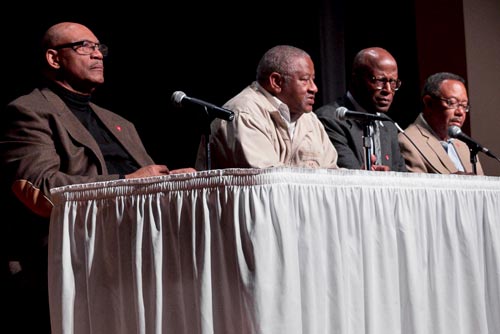African-American graduates helped change the story of ignorance and naivety toward understanding
October 16, 2017
By Greg Skoog '89

From left: Ronald Morris ’70, Lewis Nixon ’71, Charles Bush ’75, John Adams ’77.
Photo: Maggie Eli '17
“I thought you’d have a tail.”
When Ronald Morris ’70 tells the story of arriving at Saint John’s in the mid-1960s and meeting his new roommate, he’s not telling an angry story of bigotry. It’s more a bewildering story of ignorance and naivety. In one anecdote, Morris illustrated how far we’ve come and how important it is that we never stop the journey toward understanding.
“I arrived here in the summer and met my new roommate,” Morris began. “A Caucasian guy from Morris, Minnesota. And, as we were talking, he kept looking behind me. I’m a pretty direct guy, so I finally asked him, ‘Just what are you looking for?’ And he said, ‘I thought you’d have a tail.’ ”
This year, on Sept. 28, Morris came back to campus to take part in “We’ve Only Just Begun: Student Experiences During the 1970s,” a panel discussion moderated by Ken Jones, CSB/SJU professor of history. Joining Morris were Lewis Nixon ’71, Charles Bush ’75 and John Adams ’77 — four African-American SJU graduates describing their experiences on campus and in the community and sharing their perspectives with today’s students. The event was made possible by a donation from another African-American Johnnie alumnus, Charles Harvey ’74, and his wife Cheryl.
“It was culture shock,” recalled Nixon. “I went to Catholic grammar school, so I had some experience being around white people. But it wasn’t a lot.”
That initial feeling of isolation was a challenge. Nixon went home to Chicago nine times during his freshman year. “The Greyhound bus was around $11. I’d ditch my last class on Friday and catch the bus home.” At times, he struggled with whether to come back. But, he said, his mother was insistent.
Morris and Nixon went on to become two of the founders of the Organization of Afro-Associated Students (OAAS) at SJU and CSB. With Morris as president and Nixon as vice president, OAAS worked persistently with the Saint John’s administration on initiatives like getting space and funding for a black cultural center.
In the fall of 1970, however, with Morris graduated and Nixon serving in the Army, new leaders in the OAAS sought to accelerate the pace of change. Opting for a more confrontational (albeit still non-violent) approach, a group of students entered and occupied the office of SJU President Fr. Colman Barry. Nine were arrested and given 30-day suspended sentences for the incident.
“What I like to continue to [point out] is to keep it in context of what was happening throughout the country,” said Adams. Though he was not yet a student at the time, Adams sees the takeover as consistent with similar situations that were occurring on campuses nationwide. “Certainly, student protest was a very viable part of the civil rights movement. This wasn’t new stuff. It just happened to be Saint John’s time to deal with it.”
Bush isn’t so sure. As a prospective student, he had taken a campus visit just weeks before the takeover. When the news came out, he was concerned he would no longer be accepted to SJU. “In retrospect,” said Bush, “[SJU] had every legal right to expel those students. And they had every legal right to say, ‘Well, perhaps we need to go in a different direction. And perhaps these gentlemen who want to come to our school may not benefit from this education that we want to offer them. Because we don’t need this grief.’ ”
Of course, that’s not what happened. While the students were subject to the judicial system, and the takeover resulted in policy statements from both SJU and CSB warning of the consequences of similar events, the incident did raise awareness and start conversations.
“When there’s an opportunity to engage in conversation, we should do that,” said Morris.
And for students like Adams, who wouldn’t arrive on campus for several years? “My experience arriving on campus was better,” he said. “There was a critical mass of black students. We had a Black Student Union. We had friends we could go to the movies with…. And that environment was much due to the groundwork laid by these gentlemen here.”
When Morris arrived on campus in 1966, he was one of three African-American students at Saint John’s. That was 0.2 percent of the student body. This fall there are 83 African-American Johnnies – and another 56 Bennies. African-American students make up 3.7 percent of the current student body.
Nixon expressed support and encouragement for students of color in the audience, assuring them that being themselves was a surer path to harmony than trying to discern who the majority population wants them to be.
Bush was similarly encouraging. “It moves my heart so much to see you,” Bush said, “Because I never expected to see this when I left Saint John’s. I applaud all of you for being who you are and being willing to take a risk.” We’ve come a long way. But we still have a long way to go — we’ve only just begun.
